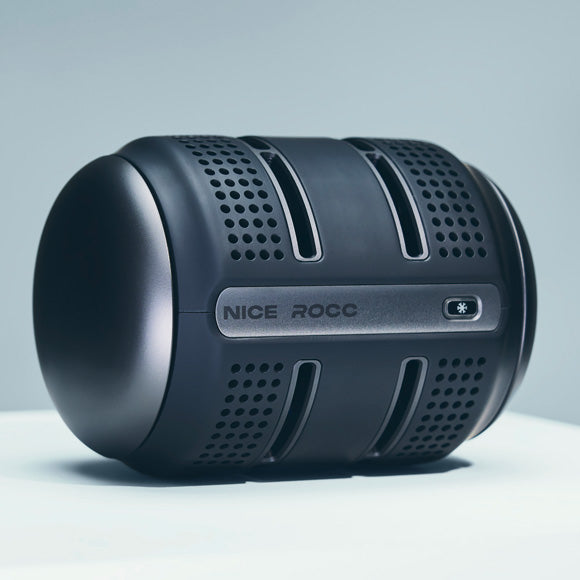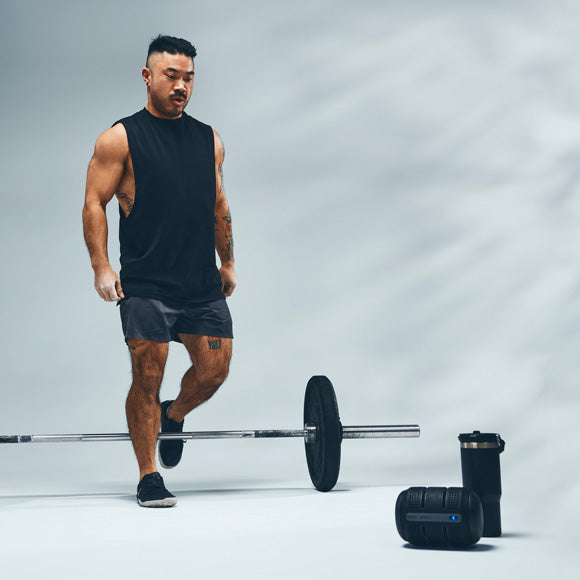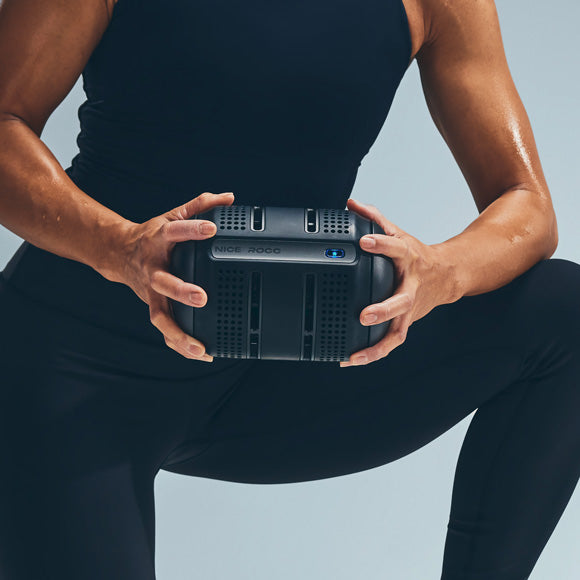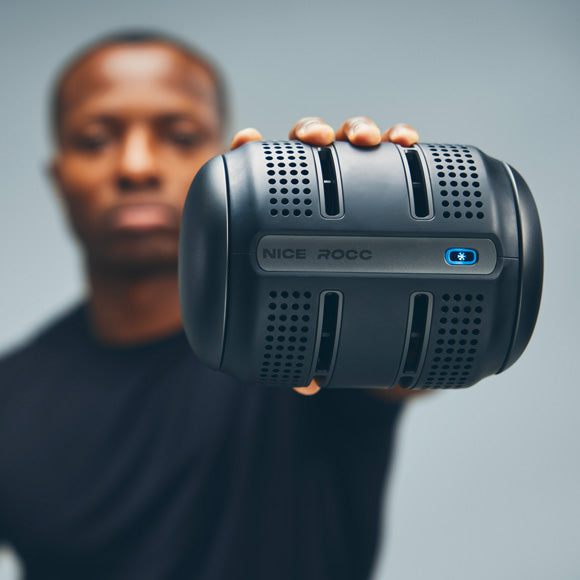Palm Cooling is a powerful approach for anyone looking to enhance performance by elevating workout intensity, reducing fatigue, and optimizing recovery. Though many athletes and fitness enthusiasts focus on traditional methods like rest intervals, hydration, a growing body of research supports the approach of regulating core temperature through the palms can dramatically improve exercise and athletic performance. According to a 2012 study led by researchers at Stanford University (Dr. Craig Heller and colleagues), cooling the hands during exercise can delay fatigue and significantly boost strength output. Professional, collegiate and amateur athletes are learning how to integrate Palm Cooling into their training routines.
Brand new to Palm Cooling? We recommend reading our comprehensive guide to what Palm Cooling is and why it’s appearing in competitions and training environments across sports and fitness including teams and athletes in NHL, NCAA, NBA, NFL, and FIFA.

Need A Quick Primer on Palm Cooling?
TL;DR: Palm Cooling helps athletes sustain power output and reduce fatigue by lowering core temperature, optimizing ATP production, and speeding up recovery. It works by cooling blood through specialized vessels in the palms (AVAs), which then circulates back to the core. Research supports its role in enhancing performance, with tools like the ROCC device making it accessible for strength training and competition.
Taking Your Training Further
Incorporating Palm Cooling into your workout routine can deliver a significant edge in both strength and endurance. Strength athletes benefit from extended power output, while endurance enthusiasts gain relief from overheating during prolonged sessions. Whether you’re pushing for a new personal record or adding extra reps to each set, the science behind Palm Cooling is increasingly recognized by coaches, sports scientists, and medical professionals alike.
Make the Most of Every Training Session
Adopting Palm Cooling in a structured, intentional way can transform the way you approach fitness. It’s an opportunity to push limits, recover faster, and achieve your goals more efficiently. Many athletes who were once skeptical are now discovering that the right cooling strategy can become a secret weapon for consistent progression.
If you’re serious about making steady gains and maximizing your body’s performance potential, Palm Cooling can be the difference-maker. Embrace a smarter cooling method, and watch your workout capacity flourish.
How to Incorporate Palm Cooling into Your Routine
1. Identify Your Training Cycles
Begin by looking at the structure of your workout. Are you focusing on strength gains, hypertrophy, or endurance? Each goal places unique demands on your body. For example, a powerlifter may train in sets of 3–5 heavy repetitions, resting up to five minutes between sets. During these rest intervals, applying Palm Cooling can be pivotal.
-
Strength-Focused Athletes: Use Palm Cooling between sets to restore ATP levels.
-
Endurance Athletes: Use Palm Cooling before or after high-intensity intervals.
-
High-Intensity Interval Training (HIIT): Alternate intervals of exercise with brief Palm Cooling sessions to manage heat buildup.
2. Time Your Cooldown Periods
Short, consistent cooldown breaks of about 1–3 minutes can be highly effective. Research published in the International Journal of Sports Science & Coaching (2021) suggests that integrating brief cooling intervals can help sustain peak power output.
Sample Approach
-
Warm-Up: Perform your usual dynamic warm-up, including mobility exercises, light cardio, and muscle activation drills.
-
Main Sets: Execute one set of your targeted exercise (e.g., barbell squats, bench press, deadlifts).
-
Palm Cooling Interval: Immediately after completing the set, place your palms on a cooling device (or hold a precisely chilled object) for 2 minutes.
-
Assess Readiness: Perform the next set once you feel a tangible drop in perceived exertion and can maintain proper form.
3. Choose the Right Cooling Device
Precision temperature control is the core principle of effective Palm Cooling. Ice is not a good source for Palm Cooling because it is typically below 50°F, triggering vasoconstriction, which hinders achieving the benefits of palm cooling. Ideally, invest in a device that maintains a range of 50–60°F.
-
Self-Contained Devices: The NICE ROCC device runs for over two hours and is the only Palm Cooling device of its kind that does require external water or ice.
-
Water-Based Cooling: While most people will find it not a practical approach, using water immersion, with a confirmed and monitored temperature between 50–60°F is also effective. However, wet hands are not effective in most training sessions requiring a strong grip such as strength training.
4. Adjust Frequency Based on Workout Intensity
Not every exercise demands the same level of cooling. Compound lifts such as squats, deadlifts, and bench presses tend to generate more muscle heat due to the large muscle groups engaged. By contrast, isolation exercises like biceps curls may generate less total heat. Adapt your Palm Cooling frequency to the intensity of your workout.
Practical Palm Cooling Protocols
Protocol A: Heavy Weight Training
-
Exercise Examples: Squats, Bench Press, Barbell Rows
-
Repetitions: 3–5 reps per set, 4–5 sets
-
Rest Interval: 3–5 minutes per set
-
Palm Cooling: Apply 50–60°F cooling for the first 2-3 minutes of rest.
Why it works: Heavy weight training elevates body temperature rapidly, especially when large muscle groups are involved. By cooling the palms promptly, athletes preserve muscle capacity for subsequent sets, potentially extending their total volume.
Protocol B: High-Intensity Training (HIIT, CrossFit, Functional Fitness, Rock Climbing, MMA Training)
-
Exercise Examples: Sprints, Battle Ropes, Kettlebell Swings, Wrestling, Climbing
-
Intervals: High intensity intervals with short seconds of rest
-
Palm Cooling: Use Palm Cooling during each rest period.
Why it works: High-Intensity Training creates a swift build-up of heat and lactic acid. Even a short burst of cooling can drop core temperature enough to restore partial ATP production, improving the consistency and intensity of repeated intervals.
Protocol C: Endurance Sessions
-
Exercise Examples: Long-Distance Running, Cycling
-
Method: Incorporate Palm Cooling during track work, treadmill, stationary bike depending on the environment’s temperature and the athlete’s heat tolerance.
Why it works: Endurance sports often suffer from gradual overheating. Intermittent cooling helps avoid the downward spiral of fatigue over long periods, stabilizing performance and heart rate.
Real-World Example: Incorporating the ROCC Device
The NICE ROCC device simplifies the incorporation of Palm Cooling. Weighing roughly 2 kg (4.4 lbs) and running for over two hours on a single charge, the ROCC is self-contained. It relies on solid-state electronics called Peltier modules. By pulling heat away from one side of the device to the other, the ROCC maintains a steady 50–60°F surface temperature—ideal for cooling without causing vasoconstriction.
Steps to Use the ROCC During a Workout
-
Prep the Device: Ensure the battery is fully charged.
-
Warm Up: Complete your standard warm-up routine to raise muscle temperature gradually and minimize injury risks.
-
Use After Intense Sets: Place one or both palms on the ROCC’s cooling surface for 60–120 seconds. Focus on staying calm and breathing slowly to allow maximum heat exchange.
-
Resume Training: Return to your exercise once you feel physically prepared and notice a small drop in heart rate or exertion level.
-
Monitor Time: A built-in haptic timer signals when the recommended cooling interval is up, removing guesswork.
The Science Behind Palm Cooling
Why Heat Leads to Fatigue
When you exercise intensely, muscle temperature rises. This increase is partly due to the breakdown of glucose for energy—a process that creates ATP. If the local temperature in muscle fibers climbs too high (often around 40°C / 104°F), essential enzymes for ATP production, such as pyruvate kinase, become inhibited. When pyruvate kinase activity drops, your muscles struggle to recycle and produce ATP, leaving you with that familiar sense of hitting a wall.
How Palm Cooling Counteracts Overheating
Palm Cooling is unlike simply dunking your hand in an ice bucket. If the skin temperature drops too low, vasoconstriction occurs—narrowing blood vessels to reduce heat loss. Unfortunately, this reflex prevents the cooled blood from effectively traveling to the heart and, by extension, to overworked muscles. Instead, Palm Cooling often uses a stable temperature range of 50–60°F (10–15.5°C). Within this sweet spot, your palms cool the blood without triggering excessive vasoconstriction, enabling a steady flow of cooled blood to your core.
Arteriovenous Anastomoses (AVAs)
AVAs are specialized blood vessels found in glabrous skin—areas like the palms, soles of the feet, and upper part of the face. Their unique structure allows for faster blood flow compared to other skin surfaces, which is exactly why focusing on the hands can cool the body more efficiently. When AVAs open, heat is more rapidly released, and cooled blood reenters circulation, helping to sustain muscle performance and accelerate recovery.
Benefits of Palm Cooling in Strength Training
Longer Workout Sets and Higher Repetition Volumes
Cooling your palms between sets can help maintain muscle ATP levels, making that third or fourth set feel more like the first. When muscles function in an optimal temperature range, performance can remain consistent for a longer period.
Faster Muscle Recovery
Lowering core temperature not only helps you push through more challenging sets but also expedites the recovery process. Instead of waiting minutes—or even hours—for body temperature to drop naturally, Palm Cooling facilitates a more direct and rapid cooldown.
Reduced Risk of Overuse Injuries
Prolonged fatigue can lead to compromised exercise form and eventual injury. By integrating Palm Cooling, you decrease the likelihood of sloppy technique due to tired muscles. Ultimately, more precise movement reduces stress on joints and tendons.
Enhanced Mental Focus
Overheating does more than just weaken your muscles. It can also contribute to mental fatigue. With core temperature under control, clarity and focus remain sharper throughout demanding workouts, promoting better mind-muscle connection.
Convenient and Portable
Advanced technologies like the NICE Recovery Systems’ ROCC device eliminate the mess of ice or water and can be used anywhere—at home, in the gym, or even at competitions.
Safety and Best Practices
-
Consult a Health Professional: Individuals with cardiovascular concerns, circulatory disorders, or any chronic health issues should speak with a doctor before introducing a new cooling regimen.
-
Avoid Overcooling: Striking the right temperature balance is crucial. Temperatures below 50°F (10°C) risk reducing blood flow to the palms, negating the benefits of Palm Cooling.
-
Stay Hydrated: Fluid intake still matters, even if you’re using Palm Cooling to manage core temperature. Dehydration can affect cardiovascular function and hamper performance.
-
Listen to Your Body: If using Palm Cooling feels uncomfortable, especially if you notice numbness or tingling in your hands, reduce cooling time or check the temperature.
-
Keep the Device Clean: Wipe down cooling surfaces after each use, especially when sharing with training partners, to maintain hygiene.
Frequently Asked Questions (FAQ)
Q: Is Palm Cooling safe?
A: Yes, most healthy individuals can use Palm Cooling without adverse effects. However, people with underlying health conditions—such as Raynaud’s disease or cardiovascular issues—should consult a healthcare provider before trying any new thermal therapy method.
Q: How quickly does Palm Cooling lower core temperature?
A: Core temperature can begin to drop within minutes, although results vary. Several studies, including a 2018 review in the Journal of Strength and Conditioning Research, indicate measurable cooling effects within 2–5 minutes of applying the right temperature range to the palms.
Q: Do I need specialized equipment, or can I just use ice packs?
A: Consistency and precision in temperature matter significantly. Ice packs can fall below 50°F, triggering vasoconstriction and reducing the effectiveness of Palm Cooling. Specialized devices like the ROCC maintain a stable 50–60°F range, ensuring optimal cooling.
Q: Is Palm Cooling beneficial for endurance athletes too?
A: Absolutely. Endurance sports often involve prolonged heat buildup in the body. By periodically cooling the palms, runners, cyclists, and triathletes can manage core temperature and delay fatigue.
Q: Can I use Palm Cooling at home?
A: Yes. Devices like the ROCC are portable and do not require an external water or ice source. Many athletes integrate Palm Cooling into home gyms to optimize workout efficiency.
Q: Can older adults benefit from Palm Cooling?
A: Older adults may find Palm Cooling particularly helpful, given that thermoregulation can decline with age. Nonetheless, consulting with a healthcare professional is advisable to ensure it aligns with individual health profiles.
Your Next Step
Elevate your performance and recovery strategy with technology designed to keep you at the top of your game. Explore NICE Recovery Systems’ ROCC device and discover how targeted Palm Cooling can become a cornerstone of a more effective training routine.




